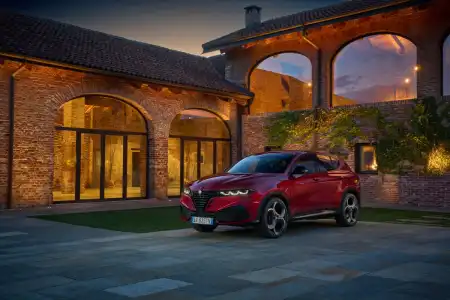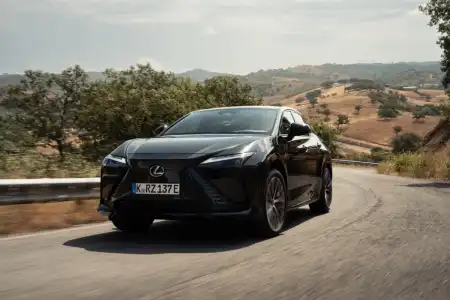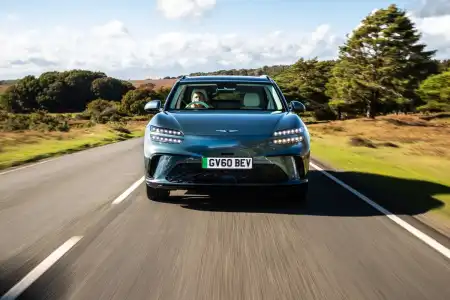- Futuristic design
- Beautifully-styled and spacious interior
- Impressive charging capabilities
- Rivals offer superior driving range
- Not the most engaging handling
- Boot is fairly compact
Introduction
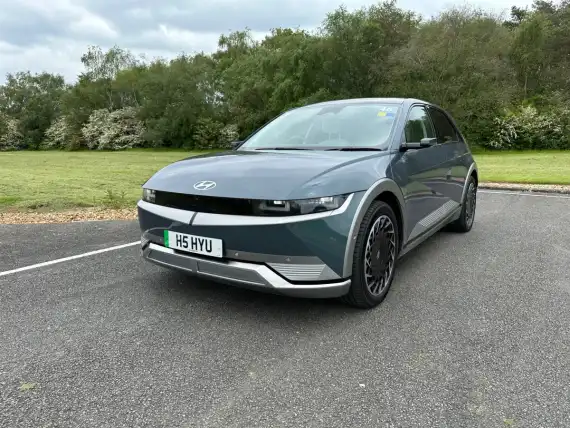
Hyundai launched its all-electric IONIQ 5 model at the beginning of 2021 and now the Korean carmaker has enhanced the multi-award-winning vehicle for 2023.
Along with a new 77.4kWh battery, the latest IONIQ 5 also features the option of video-based digital interior and exterior mirrors. And there is a new trim level joining the existing SE Connect, Premium and Ultimate versions. It is called Namsan Edition and introduces customers to the highest possible specifications and punchiest powertrains.
Namsan Edition is named after the Namsan Mountain in the Korean city of Seoul which offers spectacular views across the capital.
There is a choice of battery sizes between a 58kWh unit with 170PS or a 77.4kWh unit delivering 228PS on 2WD models, increasing to 325PS on AWD versions. We tested the 77.4kWh rear-wheel drive Namsan Edition.
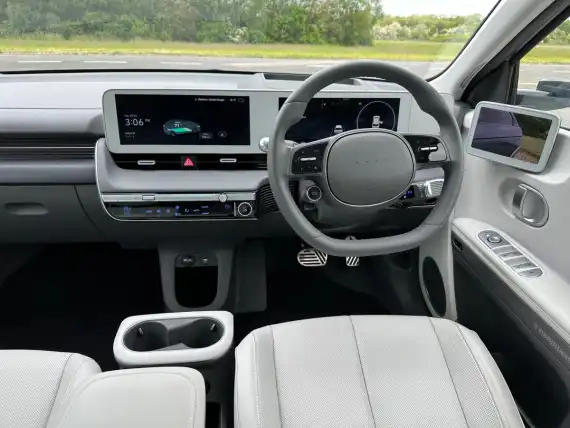
There’s no denying the strong road presence of the IONIQ 5 with distinctive, eye-catching design cues guaranteed to turn heads.
The Namsan Edition boasts a full-length vision roof presenting an unobstructed panoramic view. There are sweeping light clusters, distinctive rear lights joined by a pixel-effect bar, along with privacy glass, flush door handles and striking 20-inch alloys.
Moving inside, the modern, clutter-free interior certainly has the wow factor with cream leather upholstered seats that are powered and can be heated or ventilated. The outer rear seats can also be warmed against the winter chill.
On-board tech is plentiful in this state-of-the-art cockpit that features a 12.3-inch touchscreen navigation system, Bluetooth, Bluelink (connected car services and live services for three years), a head-up display, full smartphone connectivity via Apple CarPlay and Android Auto, a premium Bose sound system, wireless phone charging, a 12.3-inch driver information cluster and plenty of USB charging and connection ports.
Our test model also featured the quirky Digital Side Mirrors with externally-mounted cameras that project an image onto monitors at the edge of the doors. These do take a little getting used to in all honesty and I do find the digital rearview mirror a bit of a distraction when driving. That said; it is excellent if you have a full complement of passengers or a full load that obscures the standard rearview mirror and it can be switched to traditional view easily enough.
On The Road
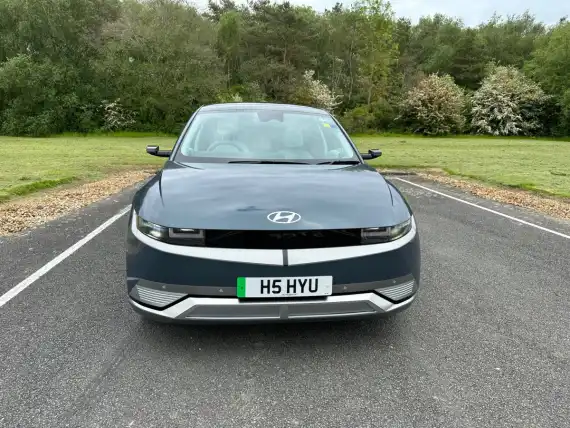
Handling & Performance
It’s always good to give customers choice and Hyundai does just that with the IONIQ 5. There are two or four-wheel drive options, four generously-equipped trims, plus the choice of a standard 58kWh battery or longer-range 77.4kWh unit.
The Hyundai IONIQ 5 Namsan Edition with 2WD, as tested, can complete the 0-62mph dash in a very respectable 7.3 seconds and tops out at 115mph. But the most important number whenever we talk about EVs is the driving range between charges. Our test car could deliver a WLTP-tested combined 295 miles.
When it comes to performance, the car is sharp out the starting blocks with instant acceleration at the slightest sign of throttle pressure. The grip is confident and assured through testing bends and there is always ample power on tap for quick bursts of pace to overtake slower vehicles.
The steering is nicely weighted with good driver feedback and the all-round visibility also impresses which makes city driving safer and more enjoyable.
Drive modes called Eco, Normal, Sport and Snow alter the driving characteristics of the car with Sport proving the most rewarding when firing through the challenging hill climbs.
As well as the drive modes, there are steering wheel-mounted paddles that are used to control the strength of the regenerative braking with three levels, along with the option of single-pedal driving which is a plus point in busy stop, start traffic.
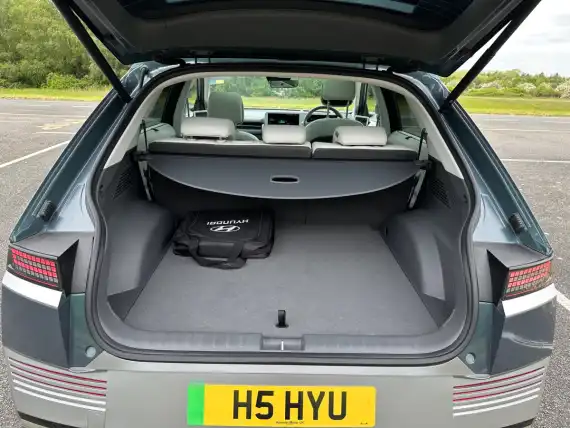
Space & Practicality
The IONIQ 5 is a large family car that stretches 4,635mm in length, is 1,890mm across (excluding door mirrors/cameras) and has a wheelbase of 3,000mm.
The interior is incredibly spacious with ample room for five occupants to sit comfortably. There are not many cars that can accommodate six footers in the back without too many complaints, but the IONIQ 5 is one of them.
The rear seats split in a 60:40 manner, but can slide forwards and backwards as well as being folded flat. And the boot can swallow 577 litres, increasing to 1,587 litres with the rear seats dropped down. There are competitors with larger boot capacities, but the IONIQ 5 is fine for most active families.
Storage options throughout the car are also impressive with a glovebox, central cubby under the front armrest, narrow door pockets, seat back nets, practical front and rear cup holders, some trays, along with a huge compartment between the front seats.
When it comes to charging the 77.4kWh battery, an 80 per cent boost can be achieved in 18 minutes via a 350kW charger.
Finally, the new battery and heater conditioning feature is standard across the line-up and this enables the IONIQ 5 to adapt its battery temperature on the move to support optimal charging conditions when it reaches the charge point. This may not sound that important, but it does improve the real-life charging performance of the car in particularly hot or cold conditions.
Ownership

Running Costs
The Hyundai IONIQ 5 is priced from £43,390 for the entry-level Premium model driven by the 58kWh 170PS battery with 2WD. The range-topper is the AWD Namsan Edition with the 77.4kWH 325PS battery and this costs £57,890. Our test car, the rear-wheel drive Namsan Edition model, was priced at £54,390.
With all IONIQ 5 models being electric vehicles, they produce zero carbon emissions and therefore benefit from a number of Government-led incentives. These include free road tax and the exemption from Congestion Charge and low emissions zone fees. However, these heartening financial bonuses, along with avoiding any premium car tax payments, will all be changing in 2025.
But, regardless of the Government’s plans to withdraw many incentives, this vehicle is still a very attractive option for business owners with an excellent Benefit in Kind tax rating of just two per cent.
The insurance rating for the IONIQ 5 Namsan Edition 2WD is group 36.
Verdict
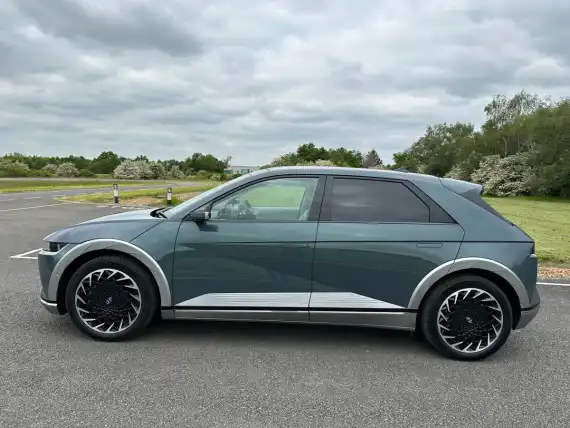
Since its launch a couple of years back, the IONIQ 5 has been scooping awards globally and these latest updates increase its appeal even further.
The top-of-the-range Namsan Edition is packed with tech without being confusing or overwhelming and it drives beautifully. Whether or not customers opt for the camera-stalks in place of traditional mirrors will be purely down to personal preference, but I would suggest test driving with them first because they are not ideal for everyone.

